Last Updated on May 24, 2025 by Lucas
Craving something light, fresh, and packed with flavor? This vibrant tabbouleh is a Mediterranean salad dream—bursting with parsley, mint, tomatoes, and a zesty lemon-olive oil dressing. Whether you’re prepping for a summer picnic or a quick weeknight side, this Middle Eastern classic comes together in just 20 minutes. Trust me, once you try this crisp, herb-packed dish, it’ll become a go-to favorite for healthy, refreshing meals. Ready to fall in love with tabbouleh all over again?
Key Benefits
A Refreshing Mediterranean Salad for Any Season
Tabbouleh is more than just a side dish—it’s a Mediterranean salad that brings brightness and balance to your plate all year round. Whether you’re enjoying a summer barbecue or craving a light winter lunch, this chilled salad fits right in. The crisp texture, citrusy tang, and herbaceous aroma create a dish that feels fresh with every bite.
- Light enough for warm-weather meals
- Brightens heavy dishes with its citrusy profile
- Pairs well with both grilled proteins and vegetarian spreads
Because it’s served cold, you can make it ahead and let the flavors deepen in the fridge—a great bonus for both weekday lunches and entertaining guests.
Packed with Nutrients from Fresh Herbs & Veggies
This light refreshing salad is also a powerhouse of plant-based nutrition. Every spoonful of tabbouleh offers a blend of fresh parsley, mint, cucumber, and tomatoes—ingredients known for their rich antioxidant content and hydration benefits.
Here’s why it’s a smart choice:
- Parsley: is packed with vitamins A, C, and K.[1]
- Mint: aids digestion and adds cooling freshness.[2]
- Tomatoes: bring lycopene and vibrant acidity.[3]
- Cucumber: hydrates and adds a satisfying crunch.[4]
Together, these vegetables create a fiber-rich combination that supports overall wellness while staying naturally low in calories.
Quick, Easy, and Perfect for Meal Prep
Time-saving meals don’t have to sacrifice flavor. This quick tabbouleh recipe comes together in under 20 minutes and doesn’t require cooking, making it ideal for meal prep salads. You only need basic chopping skills and a simple pantry dressing.
Why it works for busy routines:
- Minimal ingredients, maximum flavor
- No special tools or techniques needed
- Stays fresh for up to 3–4 days in the fridge.[5]
If you follow a plant-based or vegetarian lifestyle, tabbouleh is a versatile staple. You can enjoy it solo, mix it with lentils or chickpeas, or wrap it in flatbread for an easy lunch. Whether you’re packing lunches or hosting dinner, tabbouleh fits seamlessly into your plan.
Ingredients
Crafting authentic tabbouleh at home is all about balance—fresh herbs, crisp vegetables, and a lemony kick that brings everything to life. Let’s break down each component so you can shop and prep with confidence. If you’re new to making Mediterranean salads, don’t worry—you’re in the right place.
Below is a helpful table to organize the essential ingredients for your tabbouleh recipe:
| Category | Ingredients |
| Base Grains & Greens | Bulgur wheat (fine grind) or quinoa (for gluten-free) Fresh parsley (flat-leaf preferred) Fresh mint leaves |
| Fresh Vegetables | Ripe tomatoes (finely diced) Cucumber (English or Persian, deseeded) Green onions (thinly sliced) |
| Simple Zesty Dressing | Fresh lemon juice Extra virgin olive oil Salt Ground black pepper |
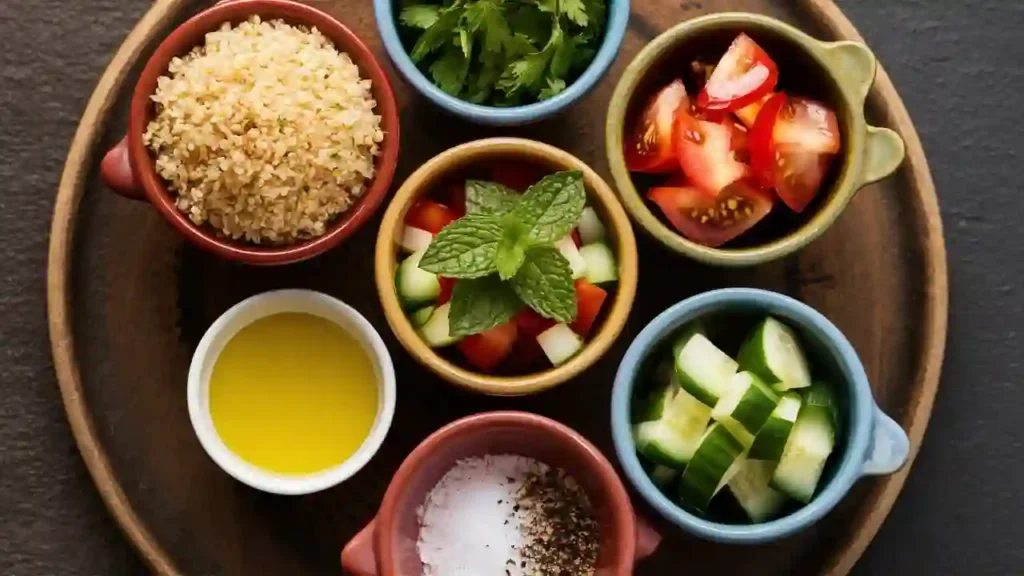
Base Grains and Greens
At the heart of traditional tabbouleh lies fine bulgur wheat—a quick-cooking whole grain that soaks up flavor beautifully. For a gluten-free twist, substitute with cooked and cooled quinoa, which maintains a similar fluffy texture.
- Use fine bulgur (No. 1 grind) for best results.
- Let it soak in boiling water or lemon juice for 15–20 minutes—no stove required.
- Chop your parsley and mint very finely. This isn’t just for looks; it gives the salad its signature texture and helps distribute flavor evenly.
Tip: Use a very sharp knife to chop herbs—this avoids bruising and keeps them fresh longer.
Fresh Vegetables
What makes tabbouleh so vibrant is the interplay between juicy tomatoes, crunchy cucumber, and sharp green onions. These ingredients bring color, hydration, and a subtle sweetness that contrasts beautifully with the earthy grains.
- Dice tomatoes small so they blend evenly. Use firm, ripe ones for the best flavor.
- Peel and deseed cucumbers if they’re large or watery to keep the salad crisp.
- For mild onion flavor, soak sliced green onions in ice water before mixing.
These vegetables aren’t just fillers—they’re central to the Mediterranean salad experience.
Simple Zesty Dressing
A well-balanced dressing ties everything together. In tabbouleh, this means fresh lemon juice, good-quality olive oil, and a generous pinch of salt and black pepper. The acidity brightens the herbs, while the oil adds richness.
- Use extra virgin olive oil for the best aroma and flavor.
- Adjust lemon juice to your taste. Some like it more tangy, others more mellow.
- Season generously, especially if using quinoa—it needs more salt than bulgur.
Optional addition: A pinch of allspice or cinnamon adds depth and is used in some regional variations.
This combination of grains, greens, vegetables, and zesty dressing is what gives tabbouleh its globally loved flavor profile. Take your time with prep—it’s worth it. Once you’ve mastered the base, you can make this dish your own with custom twists in the next sections.
Instructions
Making tabbouleh at home doesn’t have to be complicated. In fact, this plant-based Mediterranean salad is one of the easiest dishes you can master. Whether you’re meal-prepping for the week or whipping up a chilled salad for a gathering, these quick steps will guide you to a refreshing result in just 20 minutes.
Let’s walk through it—one step at a time.
Step 1: Soak or Cook the Bulgur Wheat
Your choice of grain matters. Traditional tabbouleh uses fine bulgur wheat, which doesn’t require boiling. Instead, it soaks in hot water or lemon juice and softens as you prep the rest.
- Place ½ cup fine bulgur wheat in a bowl.
- Pour in ¾ cup boiling water or lemon juice.
- Cover and let it soak for 10–15 minutes until fluffy.
- Fluff with a fork to loosen the grains.
Gluten-Free Option: Swap bulgur with cooked quinoa. Use the same volume. Cook ahead of time and allow it to cool before combining.
Tip: Always taste the grain. It should be tender but not mushy.
Step 2: Chop Fresh Herbs and Veggies Finely
The flavor of tabbouleh comes alive with vibrant herbs and crisp vegetables. For authentic texture and balance, chop everything small and even.
- Use flat-leaf parsley—you’ll need about 2 packed cups. Remove thick stems and mince finely.
- Add ½ cup fresh mint, chopped the same way.
- Dice 2 medium tomatoes—removing seeds if overly juicy.
- Peel and finely dice 1 cucumber.
- Slice 2–3 green onions, both white and green parts.
Chopping everything finely helps the flavors blend. Plus, it creates that signature fluffy tabbouleh texture.
Tip: To keep herbs fresh, dry them thoroughly before chopping. Damp herbs can make the salad soggy.
Step 3: Mix with Lemon-Olive Oil Dressing and Chill
This simple dressing brightens every bite. It’s what ties all the earthy grains and fresh produce together.
- In a small bowl, whisk together:
- ¼ cup lemon juice
- ⅓ cup extra virgin olive oil
- ½ teaspoon salt
- ¼ teaspoon black pepper
Pour the dressing over the soaked bulgur, herbs, and chopped vegetables.
- Toss gently but thoroughly.
- Adjust salt and lemon juice to taste.
- Let it chill in the fridge for 10–15 minutes before serving.
Tip: This step enhances the refreshing flavor. As it chills, the ingredients absorb the lemony dressing—making it even better over time.
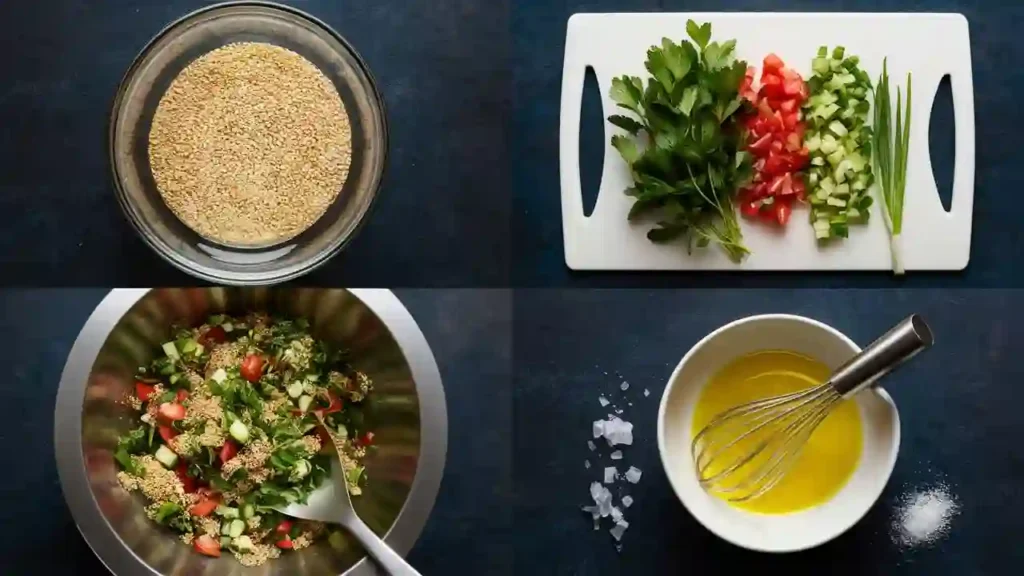
Making tabbouleh is about working with fresh, quality ingredients and keeping things simple. Each component—from the bulgur to the herbs—adds its own layer. Together, they form a vibrant, chilled salad that’s full of texture and taste.
Ready for expert tips and tasty twists? Let’s move on to the Pro Tips and Variations section.
Pro Tips and Flavorful Variations
Making tabbouleh is as much about the method as it is about the ingredients. Once you understand the foundation of this fresh herb salad, you can customize it with creative touches. Whether you’re aiming for the most authentic texture or adding new twists for variety, the tips below help you bring your tabbouleh to the next level.
Let’s explore how to make your bowl stand out—from subtle upgrades to full-on flavorful experiments.
1. Use Extra-Fine Bulgur for Best Texture
If you’re using bulgur wheat, the grind matters more than you think. For a traditional tabbouleh texture, reach for extra-fine bulgur (also labeled as #1 grind).
- This finer version doesn’t require cooking—just a quick soak.
- It blends seamlessly with the herbs and veggies.
- It creates a light, fluffy texture without heaviness.
If you’re buying bulgur in bulk or online, double-check the label. You want one that’s quick-cooking or instant. Avoid coarse bulgur for this recipe—it works better in heartier dishes like kibbeh or pilaf.
Why it matters: Extra-fine bulgur ensures your fresh herb salad stays light and refreshing instead of dense or chewy.
2. Add Pomegranate Seeds or Sumac for a Twist
Want to elevate your tabbouleh with bold flavor and color? These two Middle Eastern ingredients do just that:
- Pomegranate seeds:
- Add them just before serving for a sweet-tart pop.
- They bring vibrant color and juicy contrast.
- Ground sumac:
- Sprinkle ½ teaspoon into the dressing.
- It adds a tangy, lemony depth that pairs beautifully with parsley and mint.
These extras don’t change the essence of the dish. Instead, they enhance the flavor while staying true to the region’s culinary roots.
Flavor tip: Both pomegranate and sumac work well in larger salad spreads or when tabbouleh is used in wraps and grain bowls.
3. Make It Gluten-Free with Quinoa or Cauliflower Rice
If you’re avoiding gluten, you don’t have to miss out on tabbouleh. There are two easy swaps for bulgur wheat that keep the dish plant-based and just as tasty:
- Quinoa:
- Cooked and cooled quinoa mimics bulgur’s texture.
- It’s rich in protein and holds up well with lemon dressing.
- Cauliflower rice:
- A low-carb, grain-free alternative.
- Use raw or lightly steamed for the best crunch.
These options are perfect for those seeking a gluten-free tabbouleh or wanting to include more whole foods in their diet.
Helpful hint: If using cauliflower rice, squeeze out excess moisture after grating or processing. This keeps the salad crisp and not soggy.
Final Thought
Tabbouleh is endlessly versatile. Once you learn the base method, you can tweak it to suit your pantry, preferences, or even the season. Whether you’re sticking to tradition or leaning into innovation, these pro tips help you build a plant-based salad that’s anything but boring.
Try one of the variations above next time you make tabbouleh—and let your tastebuds guide the way.
Serving Suggestions
Once you’ve prepared your tabbouleh, you’ll find it’s more than just a side—it’s a flexible, nutrient-rich dish that easily adapts to different meals. Whether you’re creating a quick lunch, prepping for a summer gathering, or assembling a Mediterranean spread, this vegan tabbouleh fits right in.
Let’s explore how you can serve it in delicious, practical ways that align with your lifestyle and taste.
As a Standalone Vegan Meal or Side Dish
If you’re aiming for a light, satisfying option, tabbouleh stands strong on its own. Packed with fresh parsley, mint, and veggies, it’s naturally high in fiber and flavor.
- Enjoy it as a plant-based lunch when you want something refreshing and clean.
- It pairs beautifully with a drizzle of extra lemon juice or a spoonful of plain yogurt (dairy-free if needed).
- You can even toss in chickpeas or lentils to turn it into a more substantial meal.
Why it works: Tabbouleh provides a balance of hydration and nutrients, making it a smart choice for healthy eating any time of day.
Pair with Pita Bread, Hummus, or Falafel
For a more filling experience, lean into classic Middle Eastern cuisine combinations. Tabbouleh is incredibly versatile when served alongside other regional staples:
- Pita bread: Scoop the salad into warm pita pockets for a quick wrap.
- Hummus: Use tabbouleh as a topping or side to complement creamy, protein-rich hummus.
- Falafel: Create a full mezze plate with crispy falafel, tahini, and tabbouleh for a well-rounded meal.
These pairings not only elevate the taste but also bring cultural authenticity to your table.
Serving idea: Build a colorful platter with olives, sliced cucumbers, and grape tomatoes to go with your tabbouleh and dips.
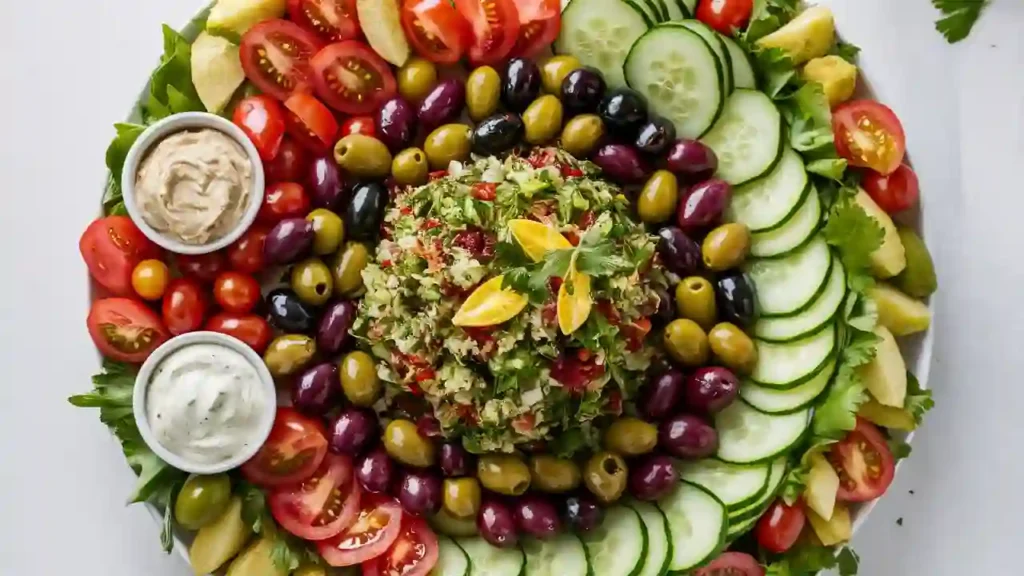
Serve Chilled at Picnics or Summer Gatherings
When temperatures rise, cold salad recipes shine. Tabbouleh is a perfect make-ahead dish for outdoor events or hot-weather meals.
- Refrigerate the salad for at least 30 minutes before serving to enhance and deepen the flavors.
- Store it in a sealed container to keep it fresh for up to 2 days.
- Pack it for picnics, potlucks, or beach lunches as a light summer dish that doesn’t require reheating.
Since it’s plant-based and made without dairy or eggs, it holds up well outside of refrigeration for short periods—ideal for casual dining under the sun.
Smart tip: If you’re traveling with tabbouleh, pack the lemon-olive oil dressing separately and mix just before serving to keep it extra crisp.
Final Thought
No matter how you serve it, tabbouleh offers you a refreshing way to eat more greens and whole foods. Try it warm with grilled vegetables or cold alongside a mezze platter. Its flavor improves over time, so it’s perfect for meal prep, gatherings, or quick, nutritious bites.
Looking to refresh your salad routine? This vegan tabbouleh is ready to step in—bright, easy, and always satisfying.
Conclusion
Tabbouleh is the kind of dish that brings freshness to your table with minimal effort. Made with finely chopped herbs, crisp vegetables, and zesty lemon dressing, it’s as easy to prepare as it is satisfying. Whether you enjoy it as a light lunch, a side to your favorite Middle Eastern dishes, or a go-to summer salad, tabbouleh fits seamlessly into a healthy lifestyle. Its vibrant flavors and nourishing ingredients make it a smart, delicious choice. Give it a try—you’ll find it’s a refreshing staple you’ll want to keep in your weekly meal rotation.
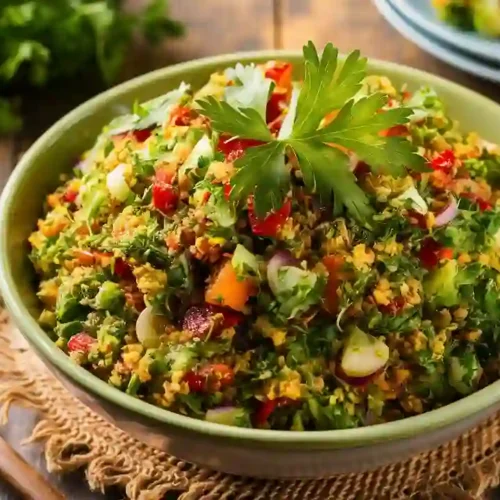
tabbouleh
Ingredients
- 1 cup bulgur wheat or quinoa for gluten-free
- 2 cups fresh parsley finely chopped
- 1/2 cup fresh mint leaves finely chopped
- 2 medium tomatoes diced
- 1 cucumber diced
- 3 green onions sliced
- 1/4 cup fresh lemon juice
- 1/4 cup extra virgin olive oil
- Salt to taste
- Black pepper to taste
Instructions
- Soak bulgur in cold water for 10 minutes, then drain. (Use cooked quinoa for gluten-free option.)
- Finely chop parsley, mint, tomatoes, cucumber, and green onions.
- In a large bowl, combine bulgur (or quinoa) with chopped veggies and herbs.
- Whisk lemon juice, olive oil, salt, and pepper in a small bowl.
- Pour dressing over salad and toss well. Chill before serving for best flavor.
Notes
- Calories: 150 kcal
- Protein: 4g
- Fat: 7g
- Carbohydrates: 18g
- Fiber: 5g
FAQs
Can I make tabbouleh ahead of time?
Yes, you can. In fact, tabbouleh tastes even better after a few hours. The flavors deepen as the herbs absorb the lemon-olive oil dressing. Just store it in an airtight container and keep it chilled.
Is traditional tabbouleh gluten-free?
Traditional tabbouleh uses bulgur wheat, which contains gluten. However, you can easily swap it for quinoa or cauliflower rice to make a gluten-free version without compromising taste or texture.
How long does homemade tabbouleh last in the fridge?
Stored properly, homemade tabbouleh stays fresh for up to 3 days. Keep it covered and cold. Stir before serving to refresh the texture.
Can I use quinoa instead of bulgur?
Absolutely. Quinoa is a great alternative. It’s light, fluffy, and gluten-free. Just cook and cool it first. Then use it the same way you would bulgur in your salad.

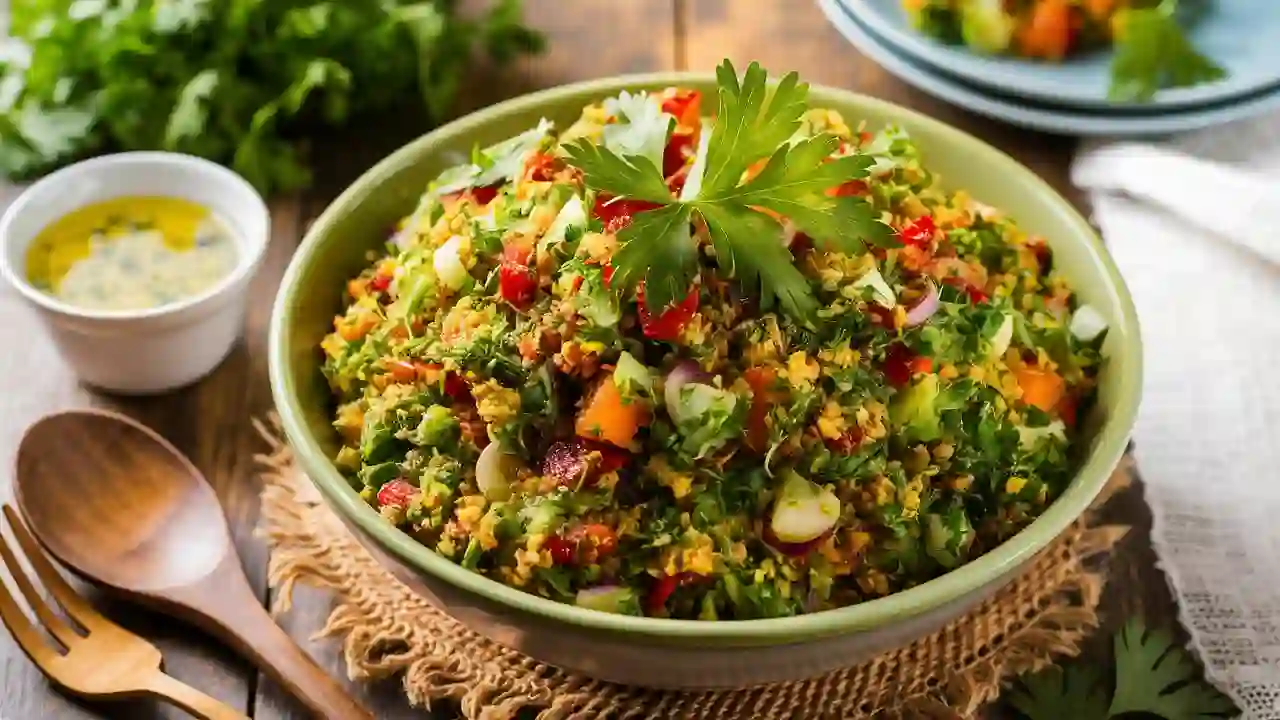
na2t9v
f1yar7